1996 CHEVROLET S10 recommended oil
[x] Cancel search: recommended oilPage 65 of 375
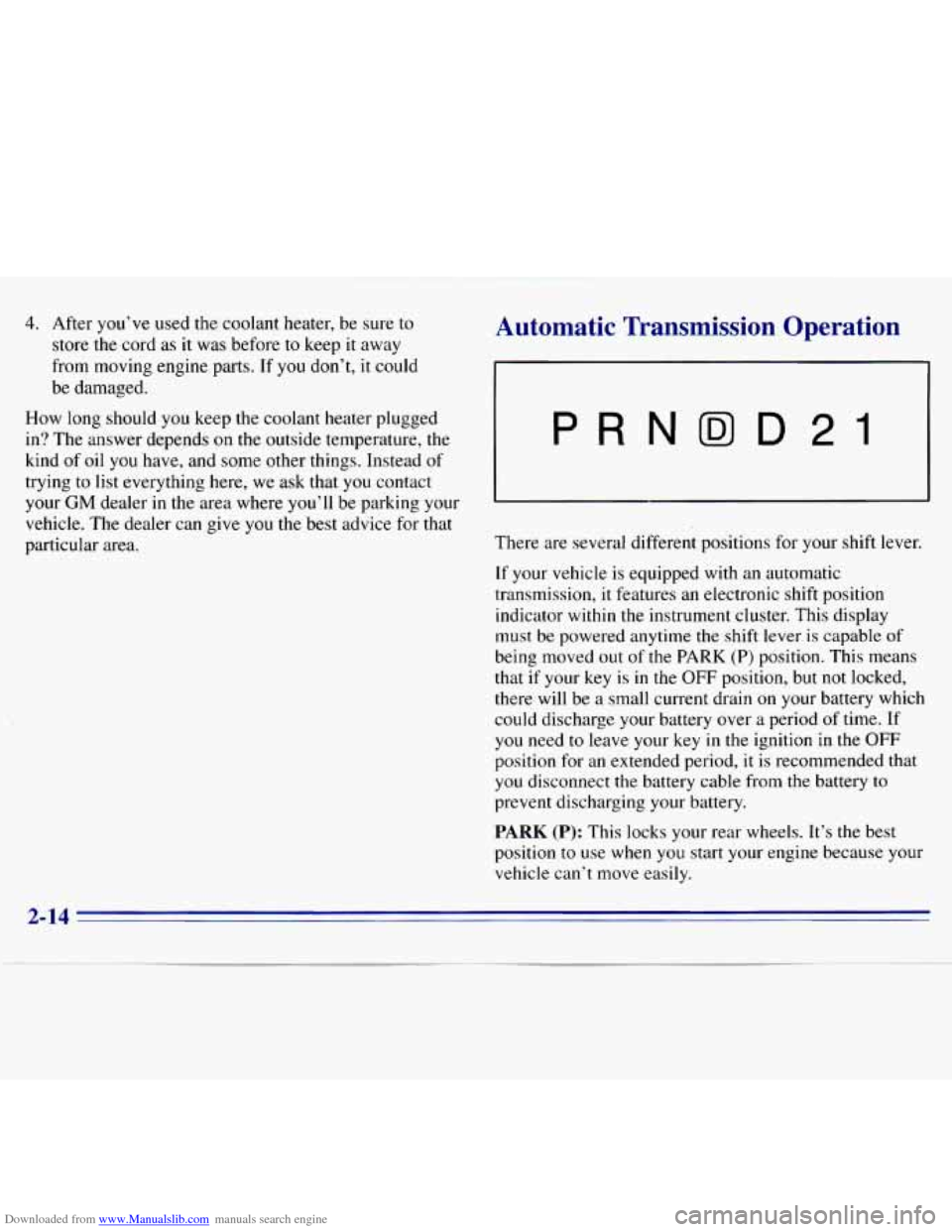
Downloaded from www.Manualslib.com manuals search engine 4. After you’ve used the coolant heater, be sure to
store the cord as it was before
to keep it away
from moving engine parts. If you don’t,
it could
be damaged.
How long should you keep the coolant heater plugged
in? The answer depends
on the outside temperature, the
kind
of oil you have, and so.me other things. Instead of
trying to list everything here, we ask that
you contact
your
GM dealer in the area where you’ll be parking your
vehicle. The dealer can give you the best advice for that
particular area.
Automatic Transmission Operation
. --
P RNDD 21
There are several different positions for your shift lever.
If your vehicle is equipped with an automatic
transmission, it features an electronic shift position
indicator within the instrument cluster. This display
must be powered anytime
the shift lever is capable of
being moved out of the PARK (P) position. This means
that
if your key is in the OFF position, but not locked,
there will be a small current drain on your battery which
could discharge your battery over a period
of time. If
you need to leave your key in the ignition in the OFF
position for an extended period, it is recommended that
you disconnect the battery cable from the battery to
prevent discharging your battery.
PARK (P): This locks your rear wheels. It’s the best
position
to use when you start your engine because your
vehicle can’t move easily.
2-14
Page 165 of 375
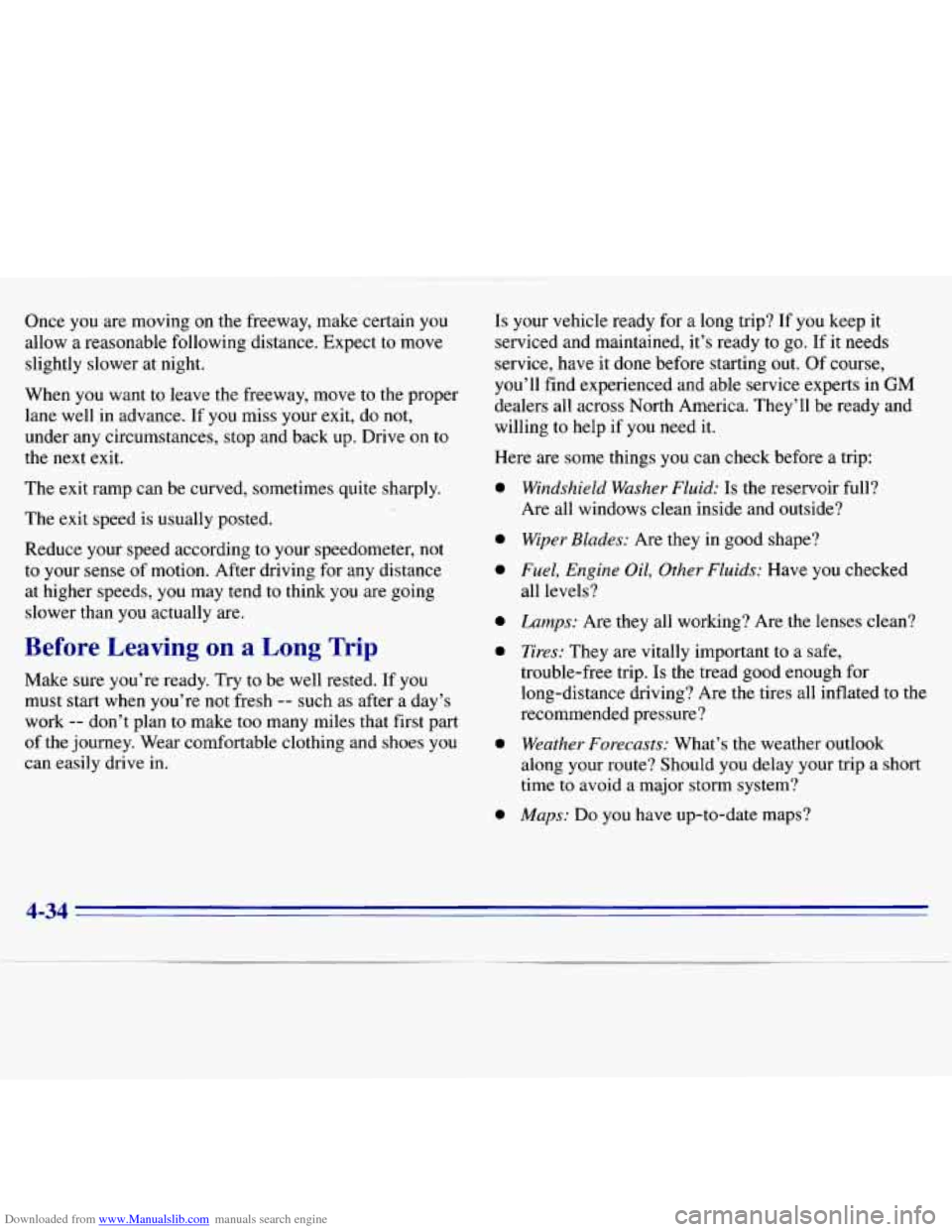
Downloaded from www.Manualslib.com manuals search engine Once you are moving on the freeway, make certain you
allow
a reasonable following distance. Expect to move
slightly slower
at night.
When you want to leave the freeway, move to the proper
lane well in advance.
If you miss your exit, do not,
under any circumstances, stop and back
up. Drive on to
the
next exit.
The exit ramp can be curved, sometimes quite sharply.
The exit speed is usually posted.
Reduce your speed according to your speedometer, ‘not
to your sense of motion. After driving for
any distance
at higher speeds, you may tend to think you are going
slower than
you actually are.
Before Leaving on a Long Trip
Make sure you’re ready. Try to be well rested. If you
must start when you’re not fresh
-- such as after a day’s
work
-- don’t plan to make too many miles that first part
of the journey. Wear comfortable clothing and shoes you
can easily drive in.
Is your vehicle ready for a long trip? If you keep it
serviced and maintained,
it’s ready to go. If it needs
service, have it done before starting out. Of course,
you’ll find experienced and able service experts in
GM
dealers all across North America. They’ll be ready and
willing to help
if you need it.
Here are some things you can check before
a trip:
0
0
0
0
0
0
0
Windshield Washer Fluid: Is the reservoir full?
Are all windows clean inside and outside?
Wiper Blades: Are they in good shape?
Fuel, Engine Oil, Other Fluids: Have you checked
all levels?
Lamps: Are they all working? Are the lenses clean?
Tires: They are vitally important to a safe,
trouble-free trip.
Is the tread good enough for
long-distance driving? Are the tires all inflated to the
recommended pressure?
Weather Forecasts: What’s the weather outlook
along your route? Should you delay your trip a short
time to avoid a major storm system?
Maps: Do you have up-to-date maps?
4-34
Page 205 of 375
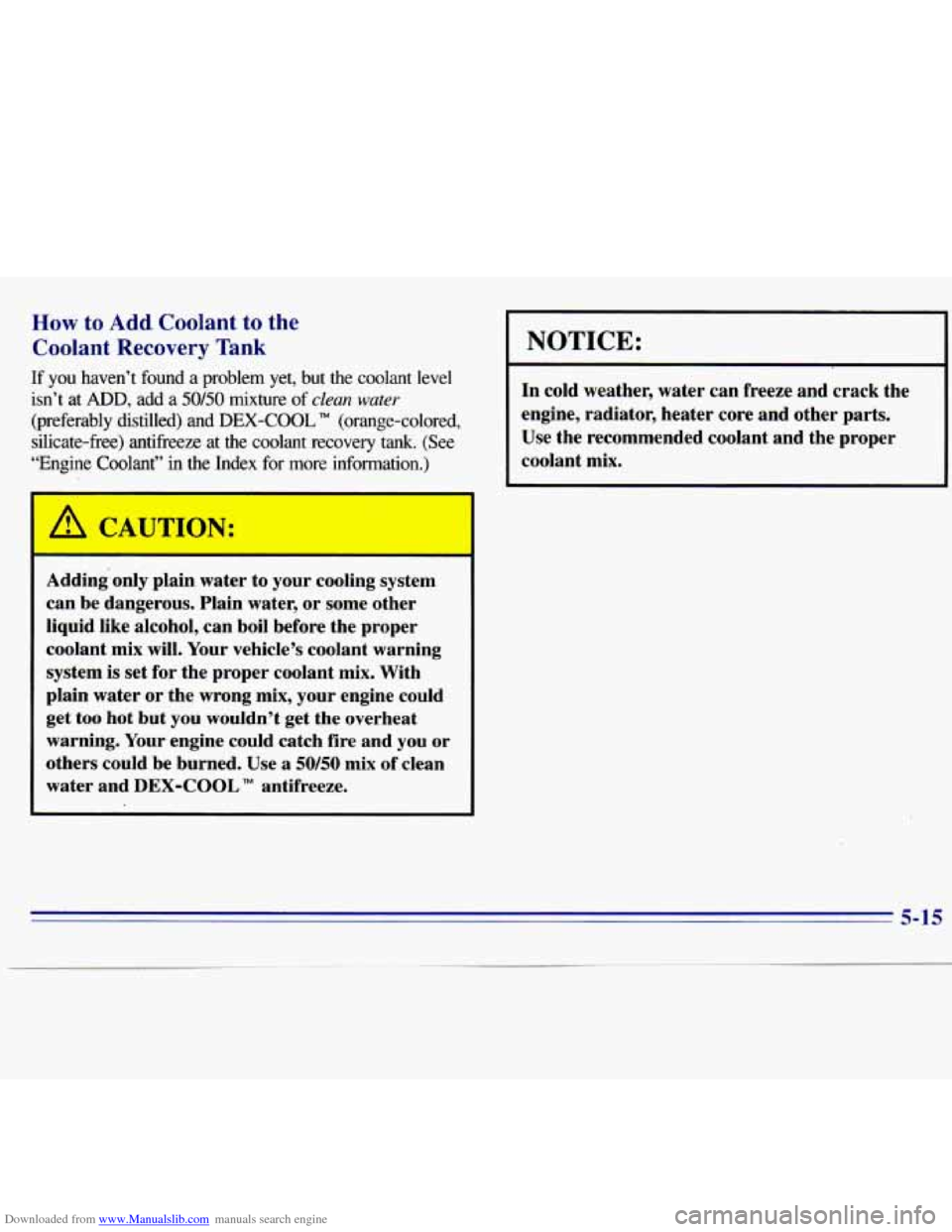
Downloaded from www.Manualslib.com manuals search engine How to Add Coolant to the
Coolant Recovery Tank
If you haven’t found a problem yet, but the coolant level
isn’t at
ADD, add a 50/50 mixture of clean water
(preferably distilled) and DEX-COOL TM (orange-colored,
silicate-free) antifreeze at the coolant recovery tank. (See
“Engine Coolant” in the Index for more information.)
k!, CAUTICJ:
Adding only plain. water to your cooling system
can be dangerous. Plain water, or some other
liquid like alcohol, can boil before the proper
coolant mix will. Your vehicle’s coolant warning
system
is set for the proper coolant mix. With
plain water or the wrong mix, your engine could
get too hot but you wouldn’t get the overheat
warning. Your engine could catch fire and you
or
others could be burned. Use a 5W50 mix of clean
water and
DEX-COOL TM antifreeze.
I NOTICE:
In cold weather, water can freeze and crack the
engine, radiator, heater core and other parts.
Use the recommended coolant and the proper
coolant mix.
Page 230 of 375
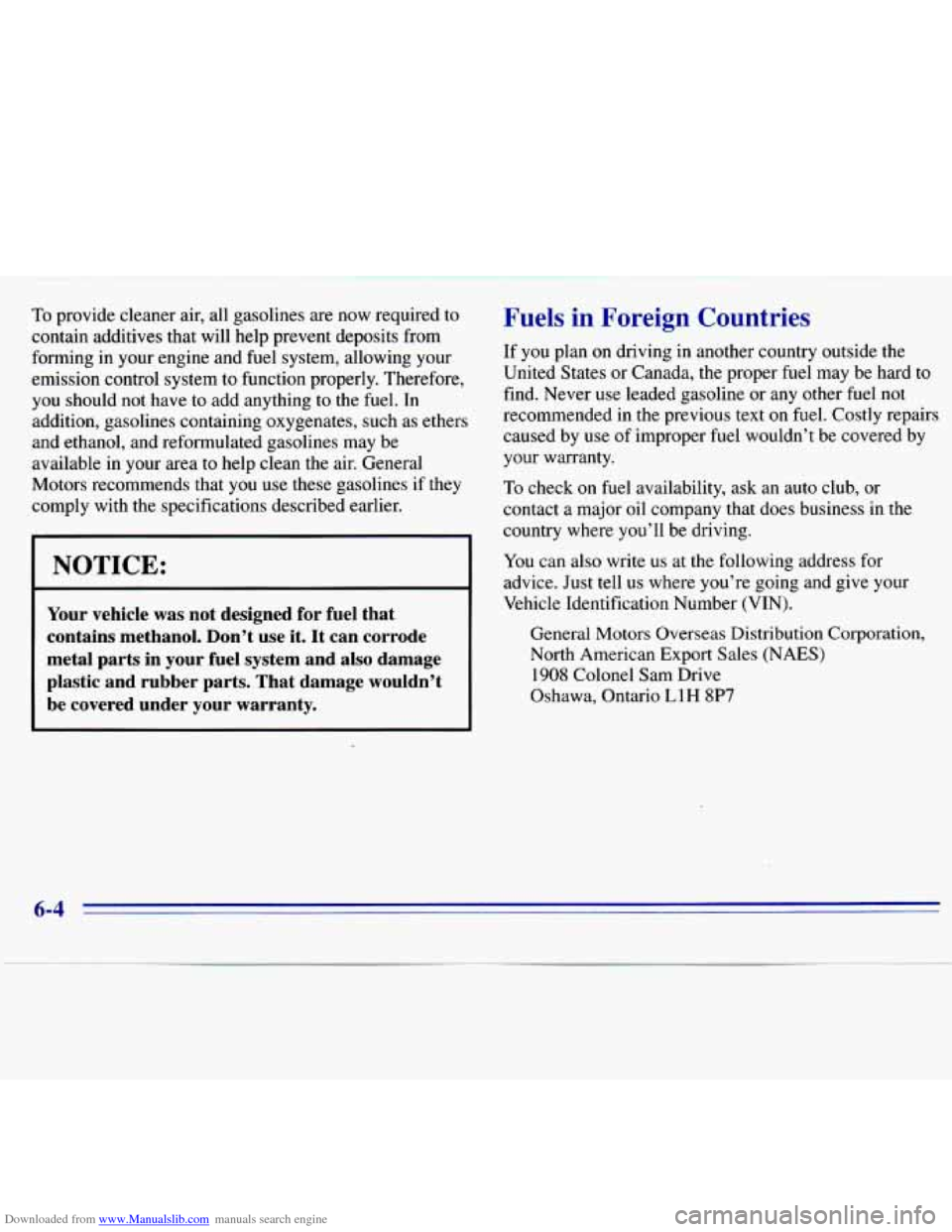
Downloaded from www.Manualslib.com manuals search engine To provide cleaner air, all gasolines are now required to
contain additives that will help prevent deposits from
forming in your engine and fuel system, allowing your
emission control system to function properly. Therefore,
you should not have to add anything to the fuel. In
addition, gasolines containing oxygenates, such as ethers
and ethanol, and reformulated gasolines may be
available in your area to help clean the air. General
Motors recommends that you use these gasolines if they
comply with the specifications described earlier.
NOTICE:
Your vehicle was not designed for fuel that
contains methanol. Don’t use it. It can corrode
metal parts in your fuel system and also damage
plastic and rubber parts. That damage wouldn’t
be covered under your warranty.
Fuels in Foreign Countries
If you plan on driving in another country outside the
United States or Canada, the proper fuel may be hard to
find. Never use leaded gasoline or any other fuel not
recommended in the previous text on fuel. Costly repairs
caused by use of improper fuel wouldn’t be covered by
your warranty..
To check on fuel availability, ask an auto club, or
contact a major oil company that does business
in the
country where you’ll be driving.
You can also write us at
the following address for
advice. Just tell us where you’re going and give your
Vehicle Identification Number (VIN).
General Motors Overseas Distribution Corporation,
North American Export Sales
(NAES)
1908 Colonel Sam Drive
Oshawa, Ontario
LlH 8P7
Page 238 of 375

Downloaded from www.Manualslib.com manuals search engine What Kind of Oil to Use
Oils recommended for your vehicle can be identified by
looking for
the “Starburst” symbol. This symbol
indicates that the oil has been certified by the American
Petroleum Institute (API).
Do not use any oil which
does not carry this Starburst symbol.
If you change your own oil, be sure you use oil that has
the Starburst symbol on the front of the oil container. If
you have your oil changed for you, be sure the oil put
into your engine is American Petroleum Institute
certified for gasoline engines.
You should also use the proper viscosity oil for your
vehicle, as shown in the following chart:
RECOMMENDED SAE VISCOSITY 6RADE ENGINE OILS
FOR BEST FULL ECONOMY AND COLD STARTING, SELECT THE LOWEST
SAE VISCOSITY GRADE OIL FOR THE EXPECTED TEMPERATURE RANGE.
HOT
WEATHER ,
“F
t. 100 -
+ sa
+ 60 .
+40.
+ 20
0.
“C
e 38
t 27
t 16
t4
-7
- 18
WOK
FOR MIS
SYMBOL
SA€ 3w-30 PREFERRED
COLD
WEATHER
DO NOT USE SAE 2OW-50 OR ANY OTHER GRADE OIL NOT RECOMMENDED
6-12
Page 239 of 375
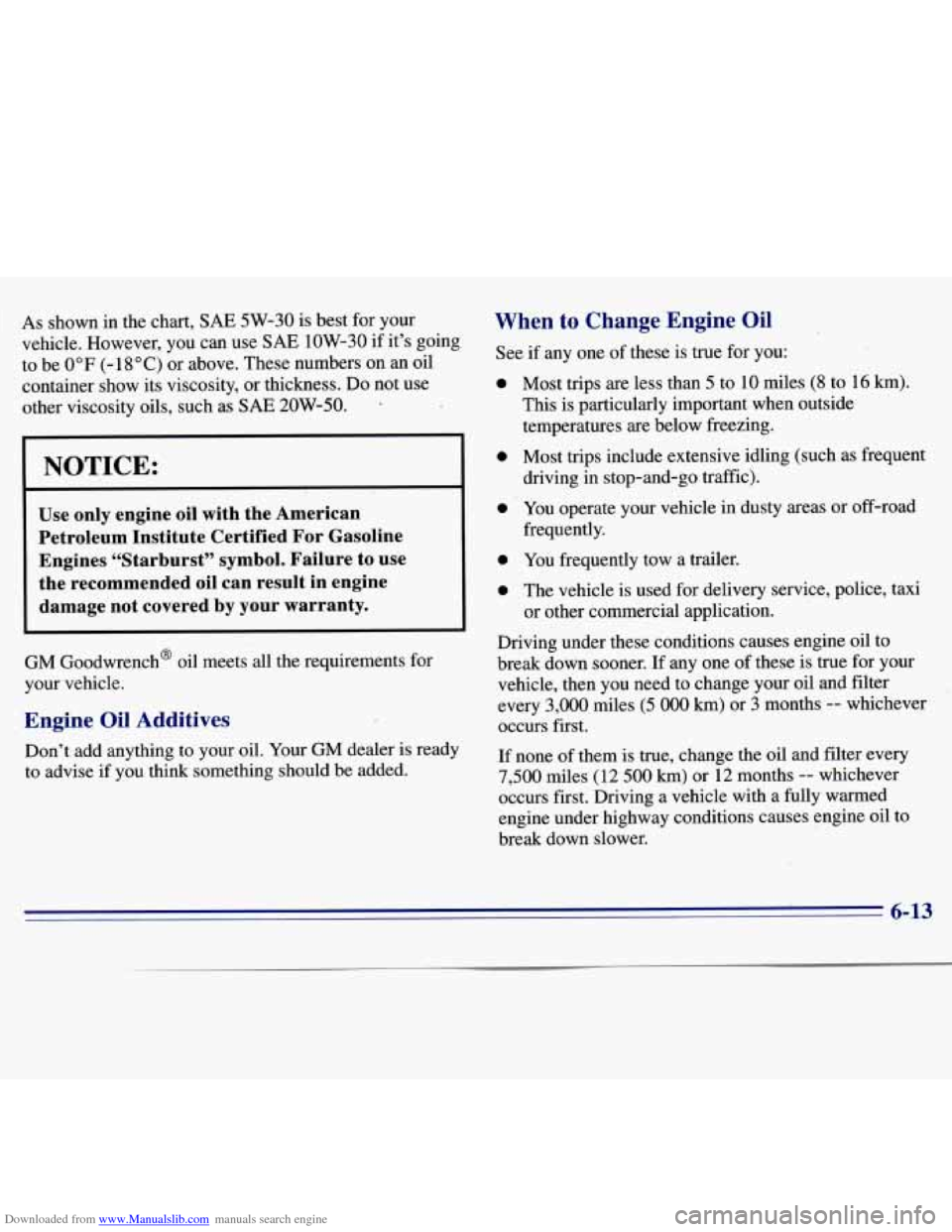
Downloaded from www.Manualslib.com manuals search engine As shown in the chart, SAE 5W-30 is best for your
vehicle. However, you can use
SAE 1OW-30 if it’s going
to be
0°F (- 18°C) or above. These numbers on an oil
container show its viscosity, or thickness.
Do not use
other viscosity oils, such as
SAE 20W-50. 7
NOTICE:
Use only engine oil with the American
Petroleum Institute Certified For Gasoline
Engines “Starburst” symbol. Failure to use
the recommended oil can result in engine
damage not covered by your warranty.
GM Goodwrench’ oil meets all the requirements for
your vehicle.
Engine Oil Additives
Don’t add anything to your oil. Your GM dealer is ready
to advise
if you think something should be added.
When te Change Engine Oil
See if any one of these is true for you:
e
e
e
8
e
Most trips are less than 5 to 10 miles (8 to 16 km).
This is particularly important when outside
temperatures are below freezing.
Most trips include extensive idling (such as frequent
driving in stop-and-go traffic).
You operate your vehicle in dusty areas or off-road
frequently.
You frequently tow a trailer.
The vehicle is used for delivery service, police, taxi
or other commercial application. I
Driving under these conditions causes engine oil to
break down sooner.
If any one of these is true for your
vehicle, then you need to change your oil and filter
every 3,000 miles
(5 000 km) or 3 months -- whichever
occurs first.
If none of them is true, change the oil and filter every
7,500 miles (12 500 km) or 12 months -- whichever
occurs first. Driving a vehicle with a fully warmed
engine under highway conditions causes engine oil to
break down slower.
6-13
Page 245 of 375
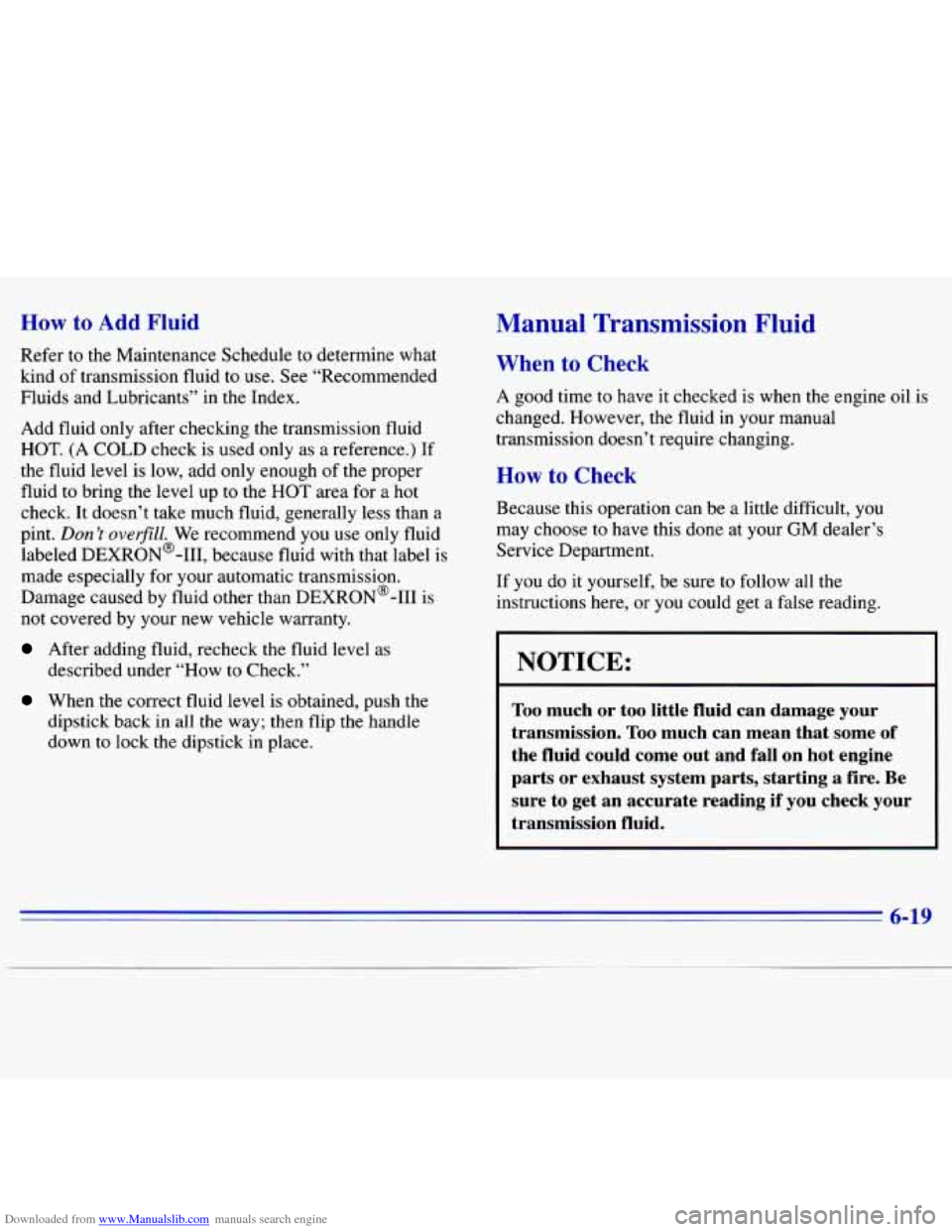
Downloaded from www.Manualslib.com manuals search engine How to Add Fluid
Refer to the Maintenance Schedule to determine what
kind
of transmission fluid to use. See “Recommended
Fluids and Lubricants” in the Index.
Add fluid only after checking the transmission fluid
HOT. (A COLD check is used only as a reference.) If
the fluid level is low, add only enough of the proper
fluid to bring
the level up to the HOT area for a hot
check. It doesn’t take much fluid, generally less than a
pint.
Don’t over-ZZ. We recommend you use only fluid
labeled DEXRON@-111, because fluid with that label
is
made especially for your automatic transmission.
Damage caused by fluid other than DEXRON@-I11 is
not covered by your new vehicle warranty.
After adding fluid, recheck the fluid level as
described under “How to Check.”
When the correct fluid level is obtained, push the
dipstick back
in all the way; then flip the handle
down to
lock the dipstick in place.
Manual Transmission Fluid
When to Check
A good time to have it checked is when the engine oil is
changed. However, the fluid in your manual
transmission doesn’t require changing.
How to Check
Because this operation can be a little difficult, you
may choose to
have this done at your GM dealer’s
Service Department.
If you do it yourself, be sure to follow all the
instructions here, or you could get a false reading.
I NOTICE:
Too much or too little fluid can damage your
transmission.
Too much can mean that some of
the fluid could come out and fall on hot engine
parts or exhaust system parts, starting a fire. Be
sure to get an accurate reading if you check your
transmission fluid.
Page 286 of 375
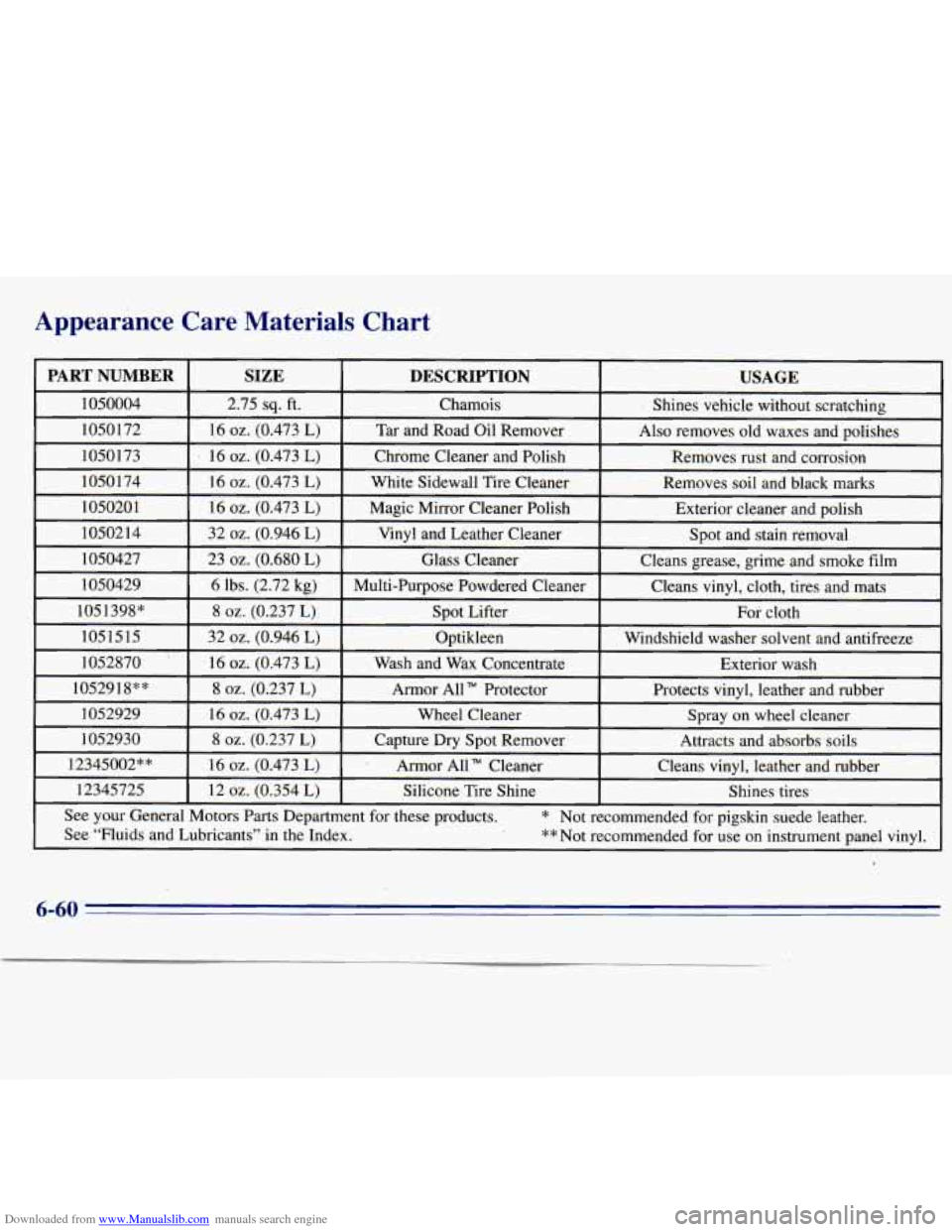
Downloaded from www.Manualslib.com manuals search engine Appearance Care Materials Chart
1051515 32 oz. (0.946 L) Optikleen Windshield washer solvent and antifreeze
1052870 16
oz. (0.473 L) Wash and Wax Concentrate Exterior wash '
I 1052918** I 8 oz. (0.237 L) I hmor All"'' Protector 7 Protects vinyl, leather and rubber
1052929
16 oz. (0.473 L) Wheel Cleaner Spray on wheel cleaner
1052930
8 oz. (0.237 L) Capture Dry Spot Remover Attracts and absorbs soils
12345002"" 16
oz. (0.473 L) .- Armor All TM Cleaner Cleans vinyl, leather and rubber
See your General Motors Parts Department for these products,
* Not recommended for pigskin suede leather.
See "Fluids and Lubricants'' in the Index.
' **Not recommended for use on instrument panel vinyl.
12345725
12
oz. (0.354 L) Silicone Tire Shine Shines tires
6-60